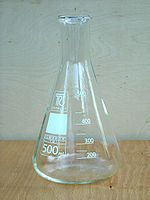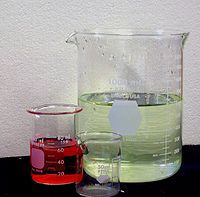![]()
![]()
![]()
Use LEFT and RIGHT arrow keys to navigate between flashcards;
Use UP and DOWN arrow keys to flip the card;
H to show hint;
A reads text to speech;
40 Cards in this Set
- Front
- Back
|
Scientific Method
|
An organized approach to problem solving
|
|
|
Control
|
Part of the experiment that is used as a basis for comparison
|
|
|
Experiment
|
A scientific test
|
|
|
Hypothesis
|
Possible explanation for a set of observations or possible answer to a scientific question
|
|
|
Data
|
Evidence; information gathered fromobservations
|
|
|
Variable
|
There should be only one of these in an experiment
|
|
|
Theory
|
well-tested explanation that unifies a broad range of explanations
|
|
|
Procedure
|
What you follow to conduct an experiment
|
|
|
(1)charts
(2) tables (3) graphs |
How does a scientists display data
|
|
|
Quantitative data
|
Numerical data
|
|
|
Qualitative data
|
Data collected that is based upon the five senses
|
|
|
Statement that sums up whether your data supports or does not support your hypothesis.
|
Conclusion
|
|
|
Factor that is changed in an experiment.
|
Manipulated variable
Independent variable |
|
|
A student needs to precisely measure the volume of a liquid.What tool would give the most precise measurement?
|
Graduated cylinder
|
|
|
Any factor in an experiment, such as time, temperature, and volume, is called a
|
Variable
|
|
|
Which type of graph is best suited to show comparisons between different items?
|
Bar graph
|
|
|
Very small measurement, used to measure objects under a microscope. µm
|
micrometer
|
|
|
Metric System standard unit of length
|
meter
|
|
|
Metric System standard unit of volume
|
liter
|
|
|
Metric System standard unit of mass
|
gram
|
|
|
10
|
1 cm = ____mm
|
|
|
1000
|
100 cm = ______mm
|
|
|
Tie hair back
|
You should do this to long hair when working in the lab
|
|
|
homeostasis
|
"maintaining balance" between an organisms internal and external environment
|
|
|
metabolism
|
the totality of chemical reactions within an organism
|
|
|
cell culture
|
group of cells derived from a single cell
|
|
|
cell fractionation
|
technique used to separate different cell parts
|
|
|
ethics
|
the study of what is right and what is wrong
|
|
|
electron microscope
|
uses a beam of electrons to produce a magnified image of an object
|
|
|
light microscope
|
uses a beam of light to produce a magnified image of an object
|
|
|
centrifuge
|
instrument that can spin a speciman so fast, that it separates with the most dense parts in th bottom of a tube and least dense rising toward the top.
|
|

|
graduated cylinder
|
|

|
Erlenmeyer flask
|
|

|
beaker
|
|

|
test tube
|
|
|
bio-
|
life
|
|
|
-ology
|
the study of
|
|
|
Biology
|
the study of living things
|
|
|
Technology
|
the practical application of scientific research to improve human life and the world in which we live
|
|
|
cell-tissue-organ-organ system-organism
|
Organization of Living Things
|

